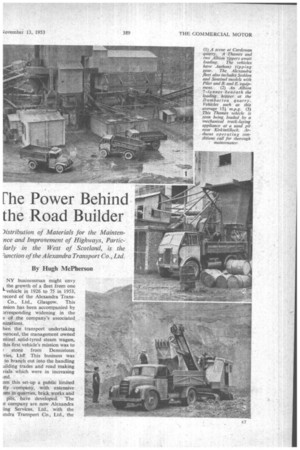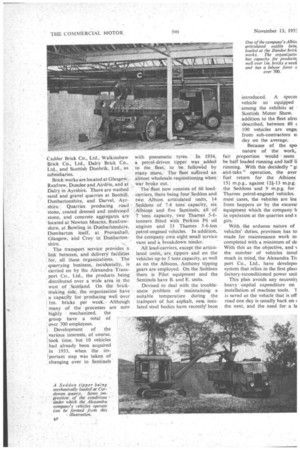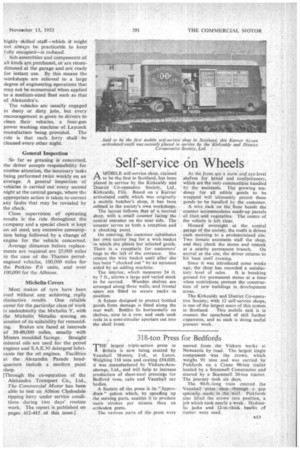rhe Power Behind the Road Builder
Page 89

Page 90

Page 95

If you've noticed an error in this article please click here to report it so we can fix it.
)istribution of Materials for the Maintennce and Improvement of Highways, Particlarly in the West of Scotland, is the 'unction of the Alexandra Transport Co., Ltd.
By Hugh McPherson
NY businessman might envy the growth of a fleet from one vehicle in 1926 to 75 in 1953, record of the Alexandra Trans Co., Ltd., Glasgow. This nsion has been accompanied by arresponding widening in the e of the company's associated nizations.
hen the transport undertaking nenced, the management owned ntinel solid-tyred steam wagon, this first vehicle's mission was to stone from Derinistoun -ries, Ltd'. This business was to branch out into the handling ailding trades and road making rials which were in increasing rid.
om this set-up a public limited ity company, with extensive :.sts in quarries, brick works and pits, have developed. The It company are now Alexandra ing Services, Ltd., with the tndra Transport Co., Ltd., the Cadder Brick Co., Ltd., Walkinshaw Brick Co., Ltd., Dairy Brick Co„ Ltd., and Scottish Dunbrik, Ltd., as subsidiaries. , Brick works are located at Glasgow, Renfrew, Dundee and Airdrie, and at Dairy in Ayrshire. There are washed sand and gravel quarries at Bonhill, Dunbartonshire, and Darvel, Ayrshire, Quarries producing road stone, coated dressed and undressed , stone, and concrete aggregates are ' located at Newton Mearns, Renfrewshire, at Bowling in DunbartOnshire, Dumbarton itself, at Provanhall, Glasgow, and Croy in Dunbarton shire.
The transport service provides a link between, and delivery facilities for, all these organizations. The quarrying business, incidentally, is carried on by the Alexandra Transport Co., Ltd., the products being distributed over a wide area in the west of Scotland. On the brickmaking side, the organization have a capacity for producing well over lm. bricks per week.Although many of the processes are now highly mechanized, the group have a total of over 700 employees.
j, Development of the various interests, of course, ; took time, but 10 vehicles had already been acquired in 1933, when the !im portant step was taken of . changing over to Sentinels with pneumatic tyres. I In 1934, a petrol-driven tipper was added to the fleet, to be followed by many more. The fleet suffered an almost wholesale requisitioning when war broke out.
The fleet now consists of 66 loadcarriers, there being four ;Seddon and two Albion articulated units, 14 Seddons of 7-8 tons. capacity, six Albions and five Sentinels, all of 7 tons capacity, two Thames 5-6tonners fitted With Perkins P6 oil engines and 33 Thames 5-6-ton petrol-engined vehicles. In addition, the company own eight small service vans and a breakdown tender. '
All load-carriers, except the articulated units, are tippers and on the vehicles up to 5 tons capacity, as well as on the Albions, Anthony tipping gears are employed. On the Seddons there is Pilot equipment and the Sentinels have 13. and E. units.
Devised to deal with the troublesome problem of maintaining a suitable temperature during the transport of hot asphalt, new insulated steel bodies have recently been introduced. A spew' vehicle so equipped among the exhibits at Scottish Motor Show.
addition to the fleet alret described, between 80 2 100 vehicles are engai from sub-contractors el day on the average.
Because of the spei nature of ' the work, fair proportion would seem be half loaded running and half Ii running. With this decidedly " gi and-take" operation, the aver fuel return for the Albions 15} m.p.g., against 14-13 m.p.g. the Seddons and 9 m.p.g. for Thames petrol-engined vehicles. most cases, the vehicles are loa from hoppers or by the excavai equipment which the company h in operation at the quarries and s pits.
With the arduous nature of vehicles' duties, provision has to made for maintenance work to completed with a minimum of de With this as the objective, and N the number of vehicles invol much in mind,. the Alexandra Tri port Co., Ltd., have develope4 system that relies in the first placx factory-reconditioned power unit This plan avoids any necessit3 heavy. -capital expenditure on installation of machine tools. T is saved as the vehicle that is off road one day is usually back on the next, and the need for a la Flighty skilled staff—which it might not always be practicable to keep fully occupied—is reduced.
Sub-assemblies and components of all kinds are purchased, or are reconditioned at the garage and are ready for instant use. By this means the workshops are relieved to a large degree of engineering operations that may not be economical when applied to a medium-sized fleet such as that of Alexandra's.
The vehicles are usually engaged in dusty or dirty jobs, but every encouragement is given to drivers to clean their vehicles, a four-gun power washing machine of Laycock manufacture being provided. The rule is that each lorry shall he cleaned every other night.
General Inspection
So far as greasing is concerned, the driver accepts responsibility for routine attention, the necessary tasks being performed twice weekly on an average. A general inspection of vehicles is carried out every second night at the central garage, where the appropriate action is taken to correct any faults that may be revealed by the check.
Close supervision of operating results is the rule throughout the company and a special check is kept on oil used, any excessive consumption being followed by a change of engine for the vehicle concerned.
Average distances before replacements are required are 25,000 miles in the case of the Thames petrolengined vehicles, 100,000 miles for the Perkins P.6 units, and over 100,000 for the Albions.
Michelin Covers Most makes of tyre have been used without any achieving re9.11y distinctive results. One reliable cover for the particular class a work undoubtedly the Michelin Y, with the Michelin Metallic scoring on account of its suitability for remoulding. Brakes are faced at intervals of 50-60,000miles, usually with Mintex moulded facings. Straight mineral oils are used for the petrol engines and S.A.E.30 detergent lubricants for the oil engines. Facilities at the Alexandra Parade headquarters inolude a modern paint shop.
[Through the co-operation of the Alexandra Transport Co., Ltd., The Commercial Motor has been able to test an Albion Clydesdale tipping lorry under service condi-. tions during two days' routine work.. The report is published on pages 412-415 of this issue.]












































































































































































































































